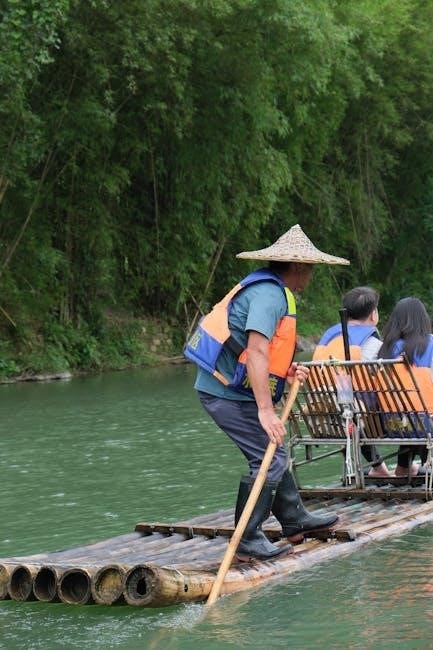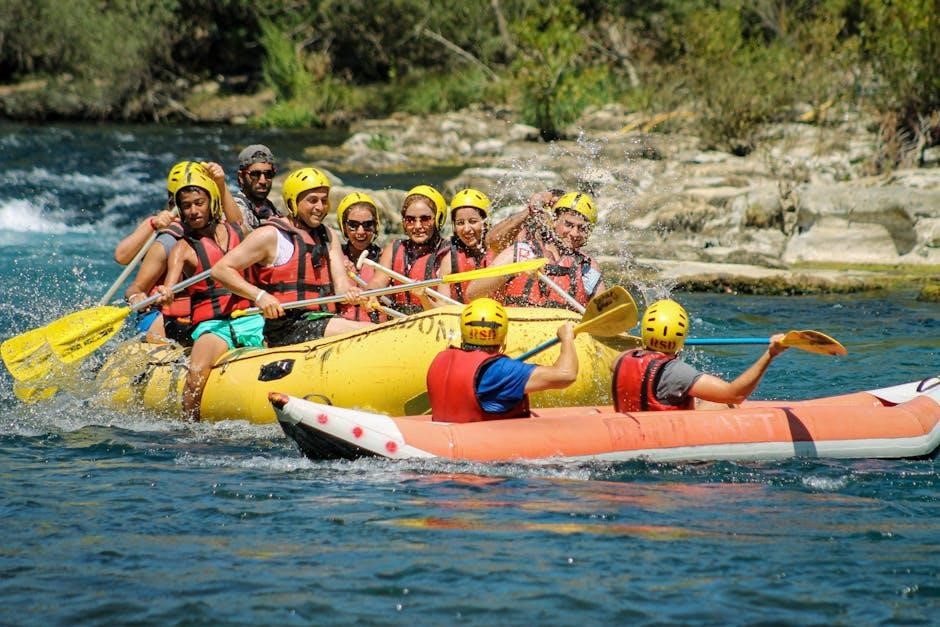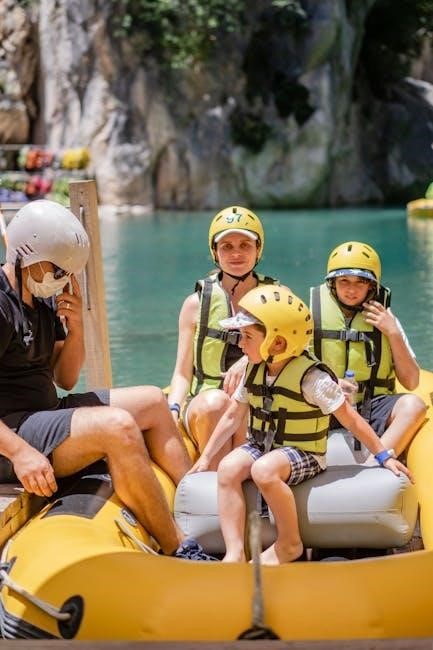
how much to tip a rafting guide
Tipping rafting guides is a common practice to show appreciation for their expertise, safety measures, and efforts to ensure an enjoyable experience. Typically, tips range from 10% to 20% of the total trip cost, translating to $3-$5 per person for half-day trips and $5-$7 for full-day trips. For multi-day adventures, $10-$15 per person is customary. Tips can be given in cash or via office envelopes, sometimes accompanied by a personal note. Regional customs and the guide’s performance may influence the amount, making it essential to research local norms and consider the trip’s complexity and additional services provided.
Importance of Tipping in the Rafting Industry
Tipping in the rafting industry is crucial as it reflects customer satisfaction and appreciation for the guide’s expertise, safety measures, and overall service quality. Guides often rely on tips as a significant portion of their income, making it a key factor in their compensation. A fair tip acknowledges their hard work and dedication to ensuring a safe and enjoyable experience. Additionally, tipping practices vary by region and cultural norms, but they universally contribute to maintaining high standards in the industry. By tipping generously, customers support the guides’ livelihoods and encourage exceptional service. It’s a way to express gratitude for the memorable experiences created during the rafting adventure. Tipping also helps in fostering a positive relationship between guides and customers, enhancing the overall quality of the service provided.
Overview of Rafting Guide Services
Rafting guides provide essential services that enhance the overall experience of a rafting trip. They are responsible for navigating the raft safely through rapids, ensuring a fun and memorable adventure. Guides also provide detailed safety briefings, assist with equipment setup, and share knowledge about the river, wildlife, and surrounding environment. Their expertise in reading water currents and handling unexpected situations is crucial for a safe journey. Additionally, guides often manage on-shore tasks, such as setting up camp for multi-day trips and preparing meals. Their comprehensive support ensures that participants can focus on enjoying their time on the water. The role of a rafting guide goes beyond just steering the raft, making their services invaluable to the success of the trip.
Why Tipping Guidelines Are Essential for Customers
Tipping guidelines provide clarity for customers, helping them understand appropriate gratuity amounts for rafting guides. Without clear standards, guests may feel uncertain about how much to tip, potentially leading to under-tipping or over-tipping. Guidelines ensure that tips reflect the quality of service received, fostering fairness for both customers and guides. They also simplify the decision-making process, allowing guests to focus on enjoying their rafting experience rather than worrying about tipping norms. Moreover, guidelines promote consistency across the industry, ensuring that guides receive fair compensation for their efforts. By offering a range or percentage-based recommendations, guidelines empower customers to make informed choices that align with their satisfaction and budget.

General Guidelines for Tipping Rafting Guides
Typically, tips range from 10% to 20% of the trip cost, with cash or envelope systems being common methods. This aligns with restaurant tipping customs, ensuring fair compensation for guides.
Standard Percentage Ranges for Tips
When determining how much to tip a rafting guide, standard percentage ranges provide a clear guideline. Typically, tips range from 10% to 20% of the total trip cost. For example, on a $200 trip, a tip of $20 to $40 is considered appropriate. This percentage-based approach aligns with common practices in industries like restaurants, where gratuity reflects the quality of service received. Some sources suggest tipping up to 25% for exceptional experiences, while others recommend a minimum of 8% to 10% for standard services. These ranges ensure fairness and provide customers with a flexible framework to express their satisfaction.
Per-Person Tipping Rates for Different Trip Durations
When planning your tip for a rafting guide, consider the duration of your trip. For a half-day trip, a tip of $3 to $5 per person is standard. This amount reflects the shorter time spent on the water and the guide’s efforts during the excursion. For a full-day trip, the recommended tip increases to $5 to $7 per person, acknowledging the guide’s extended involvement and the enhanced experience. Multi-day trips typically see higher per-person tips, ranging from $10 to $15 per person, as these adventures often involve more complex logistics and personalized service. These rates serve as a helpful starting point for customers to show appreciation for their guides’ hard work.
How Trip Cost Influences Tip Amounts
The cost of the rafting trip significantly influences the tip amount, as it reflects the value of the experience provided. Tips are often calculated as a percentage of the total trip cost, typically ranging from 10% to 20%. For example, if a half-day trip costs $100, a tip of $10 to $20 is appropriate. Similarly, for a full-day trip priced at $200, a tip of $20 to $40 would be customary. This percentage-based approach ensures that the tip aligns with the quality and expense of the service, making it a fair reflection of the guide’s efforts and the overall experience.
Higher-priced trips naturally lead to higher tip amounts, as the percentage is applied to a larger total cost. This method helps standardize tipping practices and provides a clear guideline for customers.
Comparing Rafting Tips to Restaurant Tipping Customs
Tipping rafting guides shares similarities with restaurant tipping customs, as both are based on the quality of service and the overall experience. In restaurants, a standard tip ranges from 15% to 20% of the total bill, reflecting satisfaction with the service. Similarly, rafting guides are often tipped using a percentage of the trip cost, typically between 10% to 20%, depending on the trip’s duration and complexity; Both practices emphasize rewarding exceptional service, with higher tips for outstanding experiences. However, unlike restaurants, rafting tips may also consider factors like safety, guide expertise, and additional services provided during the trip, making the tipping guidelines slightly more nuanced.

Factors Influencing Tip Amounts
Several factors influence tip amounts for rafting guides, including the quality of service, trip duration, group size, and additional services provided, such as meal preparation or photography.
Quality of Service and Guide Expertise
The quality of service and the guide’s expertise significantly impact tip amounts. Guides who demonstrate exceptional skill, ensure safety, and enhance the overall experience often receive higher tips. For instance, if a guide expertly navigates challenging rapids, provides detailed explanations, or goes above and beyond to make the trip memorable, a larger tip is appropriate. Conversely, average service may warrant a smaller tip. Many customers consider the guide’s professionalism, friendliness, and ability to handle emergencies when deciding how much to give. Exceptional service, such as arranging additional activities or sharing local knowledge, further justifies a generous tip. Thus, the guide’s performance and expertise play a crucial role in determining the final tip amount.
Length and Complexity of the Rafting Trip
The length and complexity of the rafting trip influence tip amounts. Longer trips, such as multi-day adventures, require more time and effort from guides, often resulting in higher tips. For example, a half-day trip might warrant a tip of $3-$5 per person, while a full-day trip could range from $5-$7. Multi-day trips, involving more extensive services like camping and meal preparation, typically see tips of $10-$15 per person. Additionally, trips with challenging rapids or specialized requirements may justify larger tips due to the increased skill and effort required. The duration and difficulty of the trip are key factors in determining fair compensation for the guide’s work.
Group Size and Shared Costs
Group size and shared costs play a significant role in determining tip amounts for rafting guides. Larger groups often split the tip, making it more affordable per person. For example, on a full-day trip costing $200, a tip of $20-$40 is appropriate, with each group member contributing a portion based on the total. Per-person tipping rates, such as $5-$7 for a full-day trip, are commonly used, but these can vary depending on the group’s size and the trip’s overall cost. Shared expenses encourage fairness, ensuring that the guide is adequately compensated without placing an undue burden on individual participants. This approach fosters a sense of collective appreciation for the guide’s efforts.
Additional Services Provided by Guides
Rafting guides often provide additional services that enhance the overall experience, such as photography, meal preparation, or sharing local history. These extras warrant higher tips. If a guide offers exceptional services like capturing memories or providing gourmet meals, consider tipping on the higher end of the standard range. For instance, a guide who goes above and beyond by offering insights into the region’s ecology or handling special requests deserves a more generous gratuity. Including a personal note with the tip can also express gratitude for these extra efforts, acknowledging their role in making the trip memorable. Recognizing these contributions ensures guides feel valued for their hard work and dedication.
Methods for Tipping Rafting Guides
Common methods include cash tips, office-provided envelopes for discretion, or adding a personal note. These approaches ensure convenience and express gratitude effectively for exceptional service.
Cash Tips vs. Envelope Systems
Cash tips are the most direct method, allowing customers to hand money personally to guides. This approach is straightforward and ensures immediate recognition of appreciation. However, some prefer the discretion offered by envelope systems, where tips are placed in sealed envelopes, often provided by the rafting company’s office. This method allows for privacy and can be accompanied by a personal note, adding a heartfelt touch. Both options are widely accepted, with cash being the most common and envelopes offering a more formal alternative. The choice between the two often depends on personal preference and the level of discretion desired. Ultimately, both methods ensure guides receive fair compensation for their efforts.
Including a Personal Note with Tips
Including a personal note with tips adds a heartfelt touch, allowing customers to express gratitude beyond monetary compensation. Many rafting companies provide envelopes specifically for this purpose, encouraging guests to write a few words about their experience. This practice not only enhances the gesture but also gives guides meaningful feedback. Notes can highlight exceptional service, memorable moments, or the guide’s impact on the trip. Combining a note with a tip creates a lasting impression and fosters a deeper connection between guests and guides. It’s a simple yet powerful way to acknowledge their hard work and dedication, making the appreciation feel more sincere and personal.
Office-Provided Envelopes for Discreet Tipping
Many rafting companies offer office-provided envelopes as a convenient and discreet way to leave tips for guides. These envelopes allow guests to securely place cash or personal notes without direct hand-offs, ensuring privacy and ease. Often found at check-in or check-out areas, they simplify the tipping process and eliminate any awkwardness. Envelopes may also be labeled for specific trips or guides, helping to ensure tips reach the right person. This system is especially useful for group trips, as it organizes contributions and avoids confusion. By providing envelopes, companies promote a smooth and respectful tipping experience, making it easier for customers to express their appreciation in a thoughtful manner.

Regional Variations in Tipping Practices
Tipping customs vary globally, with percentages differing based on regional norms and economic factors. For instance, tips in the US often range higher than in other countries, reflecting local standards and expectations.
Differences in Tipping Norms Across Countries
Tipping practices for rafting guides vary significantly across countries due to cultural and economic differences. In the U.S., tips typically range from 15-20% of the trip cost, mirroring restaurant tipping customs. However, in countries like Japan or South Korea, tipping is not customary and may even be considered impolite. In contrast, European countries often expect smaller gratuities, around 5-10%, reflecting regional attitudes toward service charges. These differences highlight the importance of understanding local customs to avoid misunderstandings. For instance, in some regions, tipping is expected and reflective of quality service, while in others, it may not be anticipated at all. Always research local norms before your rafting adventure to ensure appropriate compensation for your guide.
Local Customs and Expectations
Local customs and expectations play a significant role in determining how much to tip a rafting guide. In many regions, tipping is deeply rooted in cultural norms, with some areas expecting higher gratuities and others viewing it as optional. For example, in Costa Rica, tipping is customary and often reflects the quality of service, with 10-15% of the trip cost being standard. In contrast, in some European countries, tipping may be less formal, with smaller amounts expected. Understanding these local customs ensures that your gesture of appreciation aligns with regional traditions. Additionally, some outfitters include gratuity in the overall cost, while others leave it entirely to the customer’s discretion. Researching local tipping practices beforehand helps avoid misunderstandings and ensures fair compensation for guides. Always consider the cultural context to make informed decisions.
Special Circumstances for Tipping
Special circumstances, such as multi-day trips or exceptional service, may warrant higher tips. Additional services like photography or meal preparation also justify increased gratuities, reflecting the guide’s extra efforts.
Tipping for Multi-Day Rafting Trips
For multi-day rafting trips, tipping practices differ slightly due to the extended nature of the service. Typically, a tip of $10 to $15 per person is considered standard for a two-day trip, reflecting the guide’s extended efforts. Some resources suggest tipping 15-30% of the total trip cost, which can significantly increase the gratuity for longer adventures. Factors influencing these higher amounts include the guide’s role in setting up camp, preparing meals, and providing ongoing support. The quality of service and the overall experience also play a crucial role in determining the final tip amount. Guides who go above and beyond to ensure safety, entertainment, and comfort often receive higher gratuities, making multi-day trips a scenario where tipping generosity is especially appreciated.
Additional Gratuities for Exceptional Experiences
If your rafting guide exceeds expectations by providing exceptional service, safety, or memorable experiences, consider offering an additional gratuity. For outstanding performance, tipping closer to 20% of the trip cost or even slightly higher is appropriate. Some guests choose to add a personal note of appreciation along with their tip, recognizing the guide’s efforts in making the trip unforgettable. For instance, if the trip cost $200, a base tip of $40 (20%) is standard, but for extraordinary service, $50 or more would be a generous gesture. This additional amount reflects gratitude for the guide’s dedication, expertise, and ability to enhance the overall adventure, ensuring they feel valued for their hard work and professionalism.

Budgeting for Tips
Plan ahead by setting aside 10-20% of your total trip cost for gratuities. This ensures you’re prepared to fairly compensate your guide based on the service quality.
Calculating Tips Based on Total Trip Cost
To determine an appropriate tip, calculate 10-20% of the total trip cost. For example, if your rafting adventure costs $200, consider tipping between $20 and $40. This range reflects the guide’s expertise, safety measures, and effort to enhance your experience. For multi-day trips, extend this calculation to the entire cost, ensuring fair compensation for the guide’s extended service. Remember, tipping is a way to express gratitude, so adjust the amount based on the quality of service and any additional efforts made by your guide to make your trip memorable and enjoyable.
Setting Aside a Tipping Budget in Advance
Planning your tipping budget beforehand ensures you’re prepared to show appreciation for your rafting guide. Estimate 10-20% of the total trip cost and set this amount aside specifically for gratuity. For instance, if your adventure costs $200, allocate $20 to $40 for the tip. This approach prevents last-minute financial stress and allows you to enjoy your experience without worrying about additional expenses. By budgeting in advance, you can generously reward your guide based on the quality of service and the memorable moments they help create during your rafting trip.

Examples of Appropriate Tip Amounts
For half-day trips, $3-$5 per person is standard, while full-day trips typically see $5-$7 per person. Multi-day adventures often range from $10-$15 per person. Additionally, tipping 15-25% of the total trip cost is a common practice, ensuring fair compensation for guides’ efforts and expertise.
Half-Day, Full-Day, and Multi-Day Trip Examples
For a half-day rafting trip, tipping $3-$5 per person is customary, reflecting the shorter duration and standard services provided. Full-day trips typically warrant $5-$7 per person, as guides spend more time ensuring a memorable experience. Multi-day trips, which involve overnight stays and additional efforts, often see tips ranging from $10-$15 per person. These amounts can also be calculated as a percentage of the total trip cost, with 10%-20% being a common guideline. For example, a $200 trip might receive a $20-$40 tip. These examples provide a clear framework for customers to show appreciation for their guides’ hard work and dedication.
Percentage-Based Tip Calculations
Tipping rafting guides can be calculated using a percentage of the total trip cost, with 10%-25% being a standard range. For example, a $100 trip could receive a $10-$25 tip, while a $200 trip might see $20-$50. This method ensures the tip reflects the trip’s value and the guide’s contribution. Some recommend 15%-20% for exceptional service, aligning with restaurant tipping norms. Using percentages allows flexibility based on trip cost, duration, and guide performance. For multi-day trips, this percentage can be applied to the total cost, ensuring fair compensation for extended services. This approach provides a straightforward way to determine appropriate gratuities, keeping the tipping process consistent and fair for both customers and guides.
Tipping rafting guides is a meaningful way to express gratitude for their expertise and effort. Aim for 10%-25% of the trip cost, reflecting the quality of service and overall experience.
Final Thoughts on Tipping Rafting Guides
Tipping rafting guides is a gesture of appreciation for their hard work and dedication. Guides often rely on tips as part of their income, so being generous is encouraged. Consider the quality of service, trip duration, and any additional efforts made by the guide. If the guide provided exceptional service, exceeded expectations, or went above and beyond, a higher tip is warranted. Remember, tipping is not just about the money; it’s about acknowledging the effort and expertise that made your rafting experience memorable. By tipping fairly, you support the guides and ensure high-quality services for future adventurers.
Encouraging Fair Compensation for Guides
Fair compensation for rafting guides is crucial, as tips often make up a significant portion of their income. By tipping generously, you directly contribute to their livelihood and recognize their expertise. Guides work hard to ensure safety, provide education, and enhance your experience. Encouraging fair compensation not only benefits the guides but also maintains high service standards in the rafting industry. Consider the effort and skill they bring to your trip and express gratitude through appropriate tipping. This practice fosters a positive environment for both guides and future customers, ensuring exceptional experiences on the water.